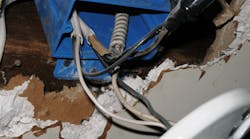How well do you know the Code? Think you can spot violations the original installer either ignored or couldn't identify? Here's your chance to moonlight as an electrical inspector and second-guess someone else's work from the safety of your living room or office. Brian, who has a knack for finding shoddy electrical work, did the dirty work and found this mess. Now it's your turn to identify the violation.
Find the Answer
This photo shows a Type AC (armored cable) cable entering a nonmetallic box, which is prohibited by 314.3. This section the Code states, "Nonmetallic boxes shall be permitted only with open wiring on insulators, concealed knob-and-tube wiring, cabled wiring methods with entirely nonmetallic sheaths, flexible cords, and nonmetallic raceways." Clearly, Type AC (armored cable) does not satisfy the conditions put forth by this wording.
There are two exceptions to this basic rule. The first recognizes the use of nonmetallic boxes with metallic raceways and cables, "Where internal bonding means are provided between all entries." However, this would require the equipment ground path from each cable entering the box to be spliced together, thereby ensuring the generally required low-impedance path for fault current, which was not done here.
The second exception permits application of metallic raceways and cables with nonmetallic boxes where the box itself provides a means for interconnection of the ground-return paths of all cables entering the box. Exception No. 2 states, "Where integral bonding means with a provision for attaching an equipment bonding jumper inside the box are provided between all threaded entries in nonmetallic boxes listed for the purpose, nonmetallic boxes shall be permitted to be used with metal raceways or metal-armored cables." But as you can see, this box does not satisfy the wording of this exception, either. Therefore, the use of Type AC with this particular nonmetallic box in this particular application is prohibited.
There are a couple of additional violations worth noting. The last sentence in 300.10, which applies to metallic raceways and cables, states "Unless specifically permitted elsewhere in this Code, raceways and cable assemblies shall be mechanically secured to boxes, fittings, cabinets, and other enclosures." This rule requires the use of a box connector. And the requirement of 300.15 calls for connectors to be used "… only with the specific wiring methods for which they are designed and listed." So, only a connector listed for use with Type AC is permissible.
Lastly, as noted in 320.40, which applies directly to Type AC terminations, "… a fitting shall be provided to protect wires from abrasion, unless the design of the outlet boxes or fittings is such as to afford equivalent protection and, in addition, an insulation bushing or its equivalent protection shall be provided between the conductors and the armor." This requirement calls for the use of the so-called "red head" between the armor and the conductors.



